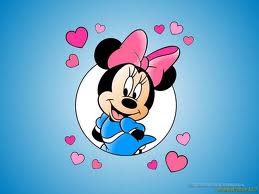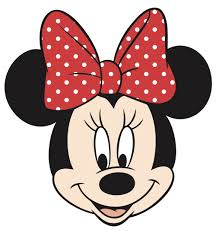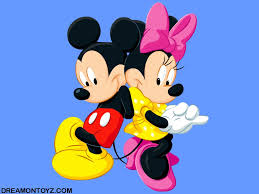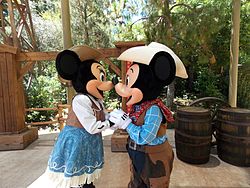Minnie Mouse
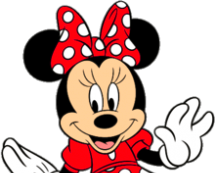
Minnie Mouse, Pluto and Figaro Cartoon – First Aiders (1944)
Minnie’s learning first aid. She asks Pluto and Figaro for help.
 Minnie Mouse – teamboat Willie (1928)
Minnie Mouse – teamboat Willie (1928)
is a cartoon character created by Ub Iwerks and Walt Disney. The comic strip story “The Gleam” (published January 19-May 2, 1942) by Merrill De Maris and Floyd Gottfredson first gave her full name as “Minerva Mouse.” Minnie has since been a recurring alias for her. Minnie is currently voiced by actress Russi Taylor. Both Minnie and Mickey were first drawn in 1928 by Ub Iwerks.
The comic strip story “Mr. Slicker and the Egg Robbers” (published September 22 – December 26, 1930) introduced her father Marcus Mouse and her mother Margie Mouse, both farmers. The same story featured photographs of her grandparents Marshall Mouse and Matilda Mouse. Her best known relatives, however, remain her uncle Mortimer Mouse and her twin nieces, Millie and Melody Mouse, though most often a single niece, Melody, appears. In many appearances, Minnie is presented as the girlfriend of Mickey Mouse, a close friend of Daisy Duck, Donald Duck‘s wife (or girlfriend), and occasionally a friend to Clarabelle Cow. Minnie’s sister, Mandie Mouse was a recurring character early on.
In 1928, Walt Disney and Ub Iwerks created Mickey Mouse to act as a replacement to his previous star Oswald the Lucky Rabbit. But Mickey could not fill the void alone. Among the few consistent character traits Oswald had developed before moving on to Universal Studios was his near-constant pursuit of potential sweethearts. So for Mickey to have a chance to emulate his predecessor at flirting, someone had to replace Oswald’s many love interests. This replacement to Miss Rabbit, Miss Cottontail, Fanny and an uncertain number of unnamed nurses and dancers was to become Minnie Mouse. She is globally recognised and a female symbol internationally.
Minnie was designed in the fashion of a “flapper” girl. She was so probably intended to follow the trends of then-modern youth culture, such as liking the color red, in an effort to add to her audience appeal. Her main outfit today usually includes a short polka-dotted dress with a matching bow and white gloves. Although she always appears in red, she was originally designed to have a blue and green outfit. In the 1929 cartoon The Karnival Kid it was also revealed that she wears black stockings. Her shoes are probably her most distinctive article of clothing. For comedic effect, she wears over-sized high heeled pumps that are too big for her feet. Her heels often slip out of her shoes, and she even loses her shoes completely in The Gallopin’ Gaucho. When she walked or danced, the clip clop of her large pumps were usually heard clearly and often went with the rhythm of the music that was played in the background. Along with Mickey, she was redesigned in the 1940s. Her hat was replaced with a large bow, and bows were added to her shoes as well. Her eyes were also given more detail. Throughout the forties and fifties, her look and personality became more conservative. This can be attributed to the fact that, as a result of The Great Depression and World War II, the culture of the USA had become more conservative, and the flapper girl style was falling out of fashion.
 Minnie first appeared in Plane Crazy. Minnie is invited to join Mickey in the first flight of his aircraft. She accepts the invitation but not his request for a kiss in mid-flight. Mickey eventually forces Minnie into a kiss but this only result in her parachuting out of the plane. This first film depicted Minnie as somewhat resistant to the demanding affection of her potential boyfriend and capable of escaping his grasp.
Minnie first appeared in Plane Crazy. Minnie is invited to join Mickey in the first flight of his aircraft. She accepts the invitation but not his request for a kiss in mid-flight. Mickey eventually forces Minnie into a kiss but this only result in her parachuting out of the plane. This first film depicted Minnie as somewhat resistant to the demanding affection of her potential boyfriend and capable of escaping his grasp.
Their debut however featured the couple already familiar to each other. The next film featuring them was The Gallopin’ Gaucho. The film was the second of their series to be produced, but the third to be released, and was released on December 30, 1928. We find Minnie employed as the Cantina Argentina, a bar and restaurant established in the Pampas of Argentina. She performs theTango for Mickey the gaucho and Black Pete the outlaw. Both flirt with her but the latter intends to abduct her while the former obliges in saving the Damsel in Distress from the villain. All three characters acted as strangers first being introduced to each other.
But it was their third cartoon that established the definitive early look and personality of both Mickey and Minnie, as well as Pete. Steamboat Willie, was the third short of the series to be produced but released first on November 18, 1928. Pete was featured as the Captain of the steamboat, Mickey as a crew of one and Minnie as their single passenger. The two anthropomorphic mice first star in a sound film and spend most of its duration playing music to the tune of “Turkey in the Straw.”
Minnie’s Yoo Hoo
Her next appearance was arguably more significant. Mickey’s Follies (June 26, 1929), featured the first performance of the song “Minnie’s Yoo Hoo”. “The guy they call little Mickey Mouse” for the first time addresses an audience to explain that he has “Got a sweetie” who is “Neither fat nor skinny” and proudly proclaims that “She’s my little Minnie Mouse“. Mickey then proceeds in explaining his reaction to Minnie’s call. The song firmly establishes Mickey and Minnie as a couple and expresses the importance Minnie holds for her male partner. Soon it would become the theme song to all of their series.
Her final appearance for the year was in Wild Waves, carried by a wave into the sea. She panics and seems to start drowning. Mickey uses a row boat to rescue her and return her to the shore but Minnie is still visibly shaken from the experience. Mickey starts singing the tune of “Rocked in the Cradle of the Deep,”, a maritime ballad, in an apparent effort to cheer her up. Minnie cheers up and the short ends. This is the second time Minnie is placed in danger and then saved by her new boyfriend. It would not be the last.
In fact this was the case with her next appearance in The Cactus Kid (April 12, 1930). As the title implies the short was intended as a Western movie parody, but it is considered to be more or less a remake of The Gallopin’ Gaucho set in Mexicoinstead of Argentina. Minnie was again cast as the local tavern dancer who is abducted by Peg-Leg Pedro (Black Pete in his first appearance with a peg-leg). Mickey again comes to the rescue. The short is considered significant for being the last short featuring Mickey and Minnie to be animated by Ub Iwerks.
The Shindig (July 11, 1930) featured Minnie joining Mickey, Horace and Clarabelle in a barn dance. Among them Clarabelle seems to be the actual star of the short. Director Burt Gillett turned in another enjoyable entry in the series, proved that production could go on without Iwerks. This was arguably the first time Minnie was upstaged by a female co-star.
In The Fire Fighters (August 6, 1930) Minnie is trapped in a hotel during a fire. She spends the duration of the short in mortal peril but is rescued by firefighters under Chief Mickey Mouse. Horace Horsecollar is among the firefighters. An unnamed cow in the background is possibly Clarabelle making a cameo. The music of the short was, appropriately, the tune of “There’ll Be a Hot Time in the Old Town Tonight.”
The next entry in the series is considered curious: The Gorilla Mystery (October 1, 1930). The short starts with Beppo the Gorilla escaping from a zoo. Mickey learns of it and panics. He phones Minnie to warn her about the dangerous gorilla wandering about. Minnie is unconcerned and plays tunes on her piano for Mickey to hear over the phone and know she is not afraid. Her tunes are interrupted by her scream and Mickey rushes to her house to save her. Meanwhile Beppo has wrapped up Minnie in rope and holds her hostage. Mickey confronts the gorilla and once again rescues the damsel in distress. The short ends with Minnie and Mickey jointly wrapping up the gorilla in rope. Modern audiences have commented on elements of bondage apparent in the short and the mysterious motivation of Beppo. Note that the theme of kidnapping by a gorilla is present here three years prior to the King Kong film of 1933.
In The Picnic, (November 14, 1930) Minnie introduces her boyfriend to her net pet dog Rover. This is actually Pluto making his first appearance as an individual character. Two unnamed bloodhound guard dogs strikingly similar to him had previously appeared in The Chain Gang (August 18, 1930) which featured Mickey incarcerated in prison without Minnie at his side. Otherwise the short features a typical picnic excursion harassed by forest animals and brought to a premature end by a sudden rain.
The final appearance of Minnie during the year was Pioneer Days (December 10, 1930). The short featured Minnie and her mate as pioneer settlers heading to the American Old West driving a covered wagon in a wagon train. They are unsurprisingly attacked by Native Americans on their way, a stock plot of Western movies at the time. While their fellows are either subjected to scalping or running for their lives, Minnie is captured by the attackers. Mickey attempts to rescue her only to be captured himself. In a reversal of their usual roles, Minnie escapes her captors and rescues her mate. They then dress as soldiers of the United States Army. Their mere appearance proves sufficient to have the entire tribe running for the hills. The Mouse couple stands triumphant at the end. The short has been criticized for its unflattering depiction of Native Americans as rather bestial predators. Their depiction as being part Jewish is not particularly fondly seen by modern audiences either. The finale has been edited out in recent viewings for depicting the “braves” submitting to cowardice.
In several shorts and on some Mickey Mouse Clubhouse episodes, Minnie owns a black and white kitten named Figaro, who had originated in the Disney animated feature Pinocchio.
During the second half of the thirties, Minnie didn’t appear as often in Mickey cartoons. This was mainly due to the growth in popularity of Mickey’s new sidekicks, Goofy and Donald Duck, whose appearances in Mickey cartoons had more or less replaced Minnie’s role. Minnie’s appearances in Mickey cartoons thus became less numerous, but she did have a few major roles in some Pluto and Figaro cartoons during the 1940s. Minnie made a sort of comeback in the 1980s when she was re-introduced in Mickey’s Christmas Carol and then got her own starring role in Totally Minnie.
Contemporary appearances
- She starred in a television show specially called Totally Minnie and she also appeared in a line of merchandise called “Minnie ‘n Me“.
- Minnie’s return to animation came in Mickey’s Christmas Carol (October 20, 1983). She was cast as Mrs. Cratchit. As with most Disney characters, she was given a small cameo in “Who Framed Roger Rabbit?” (1988).
- Minnie Mouse makes an appearance in every episode of Mickey Mouse Clubhouse.
- Minnie runs a neighborhood in Disney’s Toontown Online called Minnie’s Melodyland. This is a powerful area with access to Toontown Central, The Brrrgh, and Donald’s Dreamland.
- Minnie is available to sign autographs and take pictures throughout the day in various locations at the different Disney Resort Theme Parks around the world. She also appears in all of the daily parades that take place at the Disney resorts.
Television
 Minnie Mouse in Mickey Mouse Works (1999)
Minnie Mouse in Mickey Mouse Works (1999)
In Mickey Mouse Works, she finally appeared in her own segments. Occasionally, she starred in Maestro Minnie shorts, in which she conducts an orchestra of living instruments that she usually has to tame. In House of Mouse Minnie is in charge of running the nightclub, while Mickey primarily serves as the host, and appears in the Playhouse Disney children’s television series Mickey Mouse Clubhouse. In one episode of House of Mouse, “Clarabelle’s Big Secret,” Minnie reveals that she has gone to the movies with Mortimer Mouse, although it is not a date.

